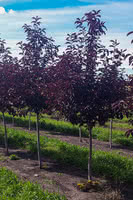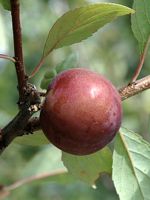Mon-Fri 9am - 5pm Mountain time
Robert Chokecherry vs Opata Cherry Plum
Prunus virginiana Robert
Prunus besseyi x salicina Opata
NOT AVAILABLE THIS SEASON - MIGHT RETURN
Developed in Barrhead, Alberta, the Robert Chokecherry produces very large berries (comparable to the size of grapes) with good yield.
The berries can be used for wine, jams, jellies and fresh picking, making it one of the sweeter chokecherries. Rich, red foliage make it a striking landscape addition.
Opata Cherry Plum is considered to be one of the best tasting Cherry Plum varieties. It has a pleasant, sweet flavour and a hint of acidity. They ripen in mid to late August and are well suited to fresh eating, baking, and preserves.
The fruit is closer to a plum than a cherry but is smaller than most plums.The Opata Cherry Plum’s skin is red/green whereas the flesh is yellow-green. The flesh is freestone with a juicy, firm texture. Similar to other stone fruits, it does not store for very long.
The Opata Cherry Plum is a hybrid between a Western Sand Cherry and a Japanese (Chinese) Plum. For fruit production, it needs to be planted with another variety for cross-pollination. Canada Plum and American Plum are considered universal pollinizers.
Robert Chokecherry Quick Facts
Opata Cherry Plum Quick Facts
Toxicity: Toxic to animals with segmented stomachs (horses, cattle, deer moose, etc.)

